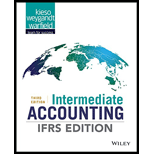
Introduction: Payment terms of 2/10, n/60 means, pay the bill amount within 10 days and avail a discount of 2%. Else, the entire amount has to be paid within 60 days.
Payment terms of 1/15, n/30 means, pay the bill amount within 15 days and avail a discount of 1%. Else, the entire amount has to be paid within 30 days.
Payment terms of 2/10, n/30 means, pay the bill amount within 10 days and avail a discount of 2%. Else, the entire amount has to be paid within 30 days.
Given: Transactions related to T B, Inc. are provided in the question.
(a)
To prepare: General
(b)
To prepare: The
Want to see the full answer?
Check out a sample textbook solution
Chapter 8 Solutions
Intermediate Accounting: IFRS Edition
- Define and differentiate between capital expenditure and revenue expenditure. Why is it important for businesses to classify these correctly in financial statements? Support your explanation with at least one example for each type of expenditure.arrow_forwardWhat are the total overhead costs assigned to Job 101?arrow_forwardSubject : Financial Accountingarrow_forward

 AccountingAccountingISBN:9781337272094Author:WARREN, Carl S., Reeve, James M., Duchac, Jonathan E.Publisher:Cengage Learning,
AccountingAccountingISBN:9781337272094Author:WARREN, Carl S., Reeve, James M., Duchac, Jonathan E.Publisher:Cengage Learning, Accounting Information SystemsAccountingISBN:9781337619202Author:Hall, James A.Publisher:Cengage Learning,
Accounting Information SystemsAccountingISBN:9781337619202Author:Hall, James A.Publisher:Cengage Learning, Horngren's Cost Accounting: A Managerial Emphasis...AccountingISBN:9780134475585Author:Srikant M. Datar, Madhav V. RajanPublisher:PEARSON
Horngren's Cost Accounting: A Managerial Emphasis...AccountingISBN:9780134475585Author:Srikant M. Datar, Madhav V. RajanPublisher:PEARSON Intermediate AccountingAccountingISBN:9781259722660Author:J. David Spiceland, Mark W. Nelson, Wayne M ThomasPublisher:McGraw-Hill Education
Intermediate AccountingAccountingISBN:9781259722660Author:J. David Spiceland, Mark W. Nelson, Wayne M ThomasPublisher:McGraw-Hill Education Financial and Managerial AccountingAccountingISBN:9781259726705Author:John J Wild, Ken W. Shaw, Barbara Chiappetta Fundamental Accounting PrinciplesPublisher:McGraw-Hill Education
Financial and Managerial AccountingAccountingISBN:9781259726705Author:John J Wild, Ken W. Shaw, Barbara Chiappetta Fundamental Accounting PrinciplesPublisher:McGraw-Hill Education





